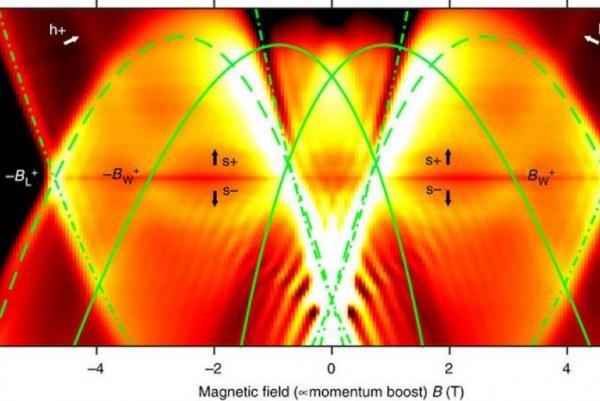Sep 19 2016
 Researchers used specific voltages and magnetic fields to control the movement of electrons across "quantum wires." Photo by University of Cambridge/Nature Communications/M. Moreno, et al.
Researchers used specific voltages and magnetic fields to control the movement of electrons across "quantum wires." Photo by University of Cambridge/Nature Communications/M. Moreno, et al.
Quantum effects have been observed in electrons by researchers who squeezed the electrons into one-dimensional ‘quantum wires’ and then observed the interactions existing between them. The results could be used to help in the progress of quantum technologies, including quantum computing.
Researchers have monitored electrons by packing them tightly enough so that they begin to display quantum effects, using an extension of the technology currently used to produce computer processors. The journal Nature Communications presents a report on this technique that has explored properties of quantum matter that creates the potential for new quantum technologies.
Controlling electrons in this way could lay the foundation for several technological advancements, including quantum computers that are capable of solving issues intractable by modern electronics. Before these technologies become practical, researchers will have to enhance their understanding of quantum, or wave-like, particles, especially the interactions existing between them.
The process of squeezing the electrons into a one-dimensional ‘quantum wire’ strengthens their quantum nature so it can be seen, by measuring at what wavelength or energy (or momentum) electrons can be injected into the wire.
Think of a crowded train carriage, with people standing tightly packed all the way down the center of the carriage. If someone tries to get in a door, they have to push the people closest to them along a bit to make room. In turn, those people push slightly on their neighbors, and so on. A wave of compression passes down the carriage, at some speed related to how people interact with their neighbors, and that speed probably depends on how hard they were shoved by the person getting on the train. By measuring this speed, one could learn about the interactions.
Professor Christopher Ford, Cavendish Laboratory, University of Cambridge
“The same is true for electrons in a quantum wire – they repel each other and cannot get past, so if one electron enters or leaves, it excites a compressive wave like the people in the train,” said the paper’s first author Dr Maria Moreno, also from the Cavendish Laboratory.
However electrons have another feature, their angular momentum or ‘spin’, which is also capable of interacting with their neighbors. Spin also has the potential to set off a wave transporting energy along the wire, and the spin waves travel at varied speeds in order to reach the charge wave.
Tunneling spectroscopy is the process used to measure the wavelength of these waves as the energy is different. Researchers from Cambridge and Harvard Universities detected the separate spin and charge waves through a number of experiments.
The Cambridge researchers have published a paper in Nature Communications where they have highlighted how they tested the latest predictions of what should take place at high energies, where the breaking down of the original theory takes place.
In the past decade, a flurry of theoretical activity resulted in new predictions of various other ways of exciting waves among the electrons, it is as if the person entering the train pushes extremely hard such that a few people fall over or even bump into others much further down the carriage. Compared to the spin and charge waves, these new modes are considered to be weaker and even harder to identify.
Collaborators of the Cambridge researchers from the University of Birmingham predicted the existence of a chain of modes matching the different ways in which the interactions can influence the quantum-mechanical particles, the weaker modes should be the most powerful in extremely short wires.
The Cambridge researchers developed a set of short wires by working out a new method of contacting a set of 6000 narrow strips of metal used to produce the quantum wires from the semiconducting material gallium arsenide (GaAs). This required an additional layer of material in the shape of bridges existing between the strips.
It was possible to map out the tunneling from the wires to an adjacent sheet by varying the voltage and the magnetic field. This provided evidence for the additional curves predicted, where it can be viewed as an upside-down model of the spin curve.
These results are now used to improve the understanding and behavior of electrons present in the building blocks of a quantum computer.